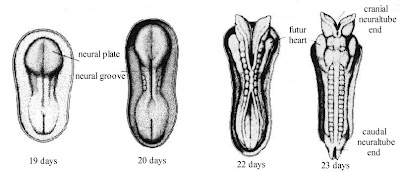But even if you are not actively trying to get pregnant one should still take folic acid if you are engaging in any acts that may result in pregnancy. This is because the early spinal cord of the embryo begins as a flat region, which rolls into a tube (the neural tube) 28 days after the baby is conceived. When the neural tube does not close completely, an NTD (Neural Tube Defect) develops. NTDs develop before most women know they are even pregnant.
Its a good idea to increase your folic acid dosage even if you have not had history of a prior NTD. I am living proof that taking the recommended dosage does not prevent all NTDs. I was on the recommended dosage 3 months before trying to conceive and all through my pregnancy with Genesis. Had I been taking more folic acid she may have not been born with anencephaly. Though know that even with an increased intake of folic acid there is still a 1% chance you may have a child with a NTD. Another thing to keep in mind is that most people who have a child with a NTD hav had no prior family history of NTDs.
How a woman can get enough folic acid?
There are two easy ways to be sure to get enough folic acid each day:
What Foods Contain Folic Acid?
Approximately half of all pregnancies are unplanned, so the U.S. Food and Drug Administration has taken steps to fortify certain foods so that all women of childbearing age get a daily dose of folic acid. The following foods can help you obtain your recommended amount of folic acid:
- Leafy green vegetables, such as large spinach salad
- Citrus fruits, such as orange juice
- Beans
- Breads
- Cereals
- Rice
- Pastas
Can You Overdose On Folic Acid?
Folic acid has no known toxic level. If you were to eat a bowl of fully fortified cereal (400 micrograms), take 400 micrograms (0.4 milligrams) folic acid supplement, and eat fortified foods and foods rich in folate, women of reproductive age would not have a problem with too much folic acid. Even in very high amounts folic acid is non-toxic. Nevertheless, it is recommended that women consume no more than 1,000 micrograms of synthetic folic acid a day. Large amounts of folic acid may hide the ability to quickly diagnose pernicious anemia, a rare vitamin B-12 deficiency. This condition primarily affects the elderly population and, in some cases, can lead to neurological damage. Today, Doctors can use a simple definitive test to check for a B-12 deficiency. Folic acid is water-soluble. Water-soluble vitamins dissolve in water. Leftover amounts of the vitamin leave the body through the urine. That means you need a continuous supply of the vitamin in your diet. Because of this, overdose is not likely. Anything your body cannot absorb gets excreted through your urine.
Findings from a survey conducted in 1998 to assess folic acid knowledge and practices among women of childbearing age in the United States indicate that of all women surveyed, only 13% knew that folic acid helps prevent birth defects, and only 7% knew that folic acid should be taken before pregnancy to prevent birth defects.
You should not take folic acid if you have any of these conditions. You may need a dose adjustment or special tests to safely use folic acid:
- Kidney disease (or if you are on dialysis)
- Hemolytic anemia
- Pernicious anemia
- Anemia that has not been diagnosed by a doctor and confirmed with laboratory testing
- An infection
- If you are an alcoholic
- If you are allergic to folic acid
Who Is At Risk:
NTD-affected pregnancy. It is not possible to predict which women will have a pregnancy affected by an NTD. 95% of NTDs occur in women with no personal or family history of NTDs. However, some risk factors are known:
- An NTD-affected pregnancy increases a woman's chance to have another NTD-affected pregnancy by approximately twenty times
- Maternal insulin-dependent diabetes
- Anti-seizure medication use
- Medically diagnosed obesity
- High temperatures in early pregnancy (prolonged fevers and hot tub use, for example)
- Race/ethnicity (NTDs are more common among white women than black women and more common among Hispanic woman than non-Hispanic women)
- Lower socio-econimic status
Types Of Neural Tube Defects (NTDs)
There are two types of NTDs. The most common type are called the open NTDs. Open NTDs occur when the brain and/or spinal cord are exposed at birth through a defect in the skull or vertebrae (back bones). Examples of open NTDs are spina bifida (myelomeningocele), anencephaly, and encephalocele. Rarer types of NTDs are called closed NTDs. Closed NTDs occur when the spinal defect is covered by skin. Common examples of closed NTDs are lipomyelomeningocele, lipomeningocele, and tethered cord.
Lastly, spina bifida occulta (SBO) is potentially another form of an NTD in which there is a typically benign (or non-symptom-causing) bony change in one or more vertebrae, but not involving the nerves within the spinal column. The incidence of SBO is not well defined; however, it is more common than the NTDs described above. The cause and potential similarities, or, link to NTDs, has not been established.
Even More Folic Acid Resources:

